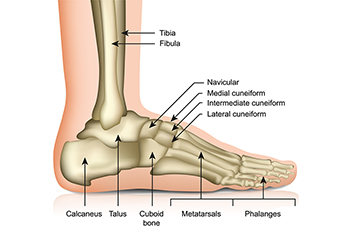
The feet are considered to be one of the most complex parts of the body. Each foot has 26 bones, and a number of ligaments, tendons, and muscles that work in harmony to keep us mobile. The bones in the feet are divided into three categories. Seven bones make up the first group, known as the tarsal bones. These include the ankle and heel bone, in addition to the bones that form the arch. The metatarsals are the next set of foot bones that are found in the center of the foot. They connect the tarsal bones to the phalanges, which is the third group of bones. These are found in the toes, and aid in balancing the body. Some of the foot conditions that can affect the foot bones are arthritis, gout, bunions, and hammertoe. Additionally, the heel bone is targeted when heel spurs or plantar fasciitis develops. If you would like more information about the structure of the foot, it is suggested that you consult with a podiatrist who can provide you with interesting foot facts.
If you have any concerns about your feet, contact Scott Matthews, DPM, MD from Salem Foot Care . Our doctor can provide the care you need to keep you pain-free and on your feet.
Biomechanics in Podiatry
Podiatric biomechanics is a particular sector of specialty podiatry with licensed practitioners who are trained to diagnose and treat conditions affecting the foot, ankle and lower leg. Biomechanics deals with the forces that act against the body, causing an interference with the biological structures. It focuses on the movement of the ankle, the foot and the forces that interact with them.
A History of Biomechanics
- Biomechanics dates back to the BC era in Egypt where evidence of professional foot care has been recorded.
- In 1974, biomechanics gained a higher profile from the studies of Merton Root, who claimed that by changing or controlling the forces between the ankle and the foot, corrections or conditions could be implemented to gain strength and coordination in the area.
Modern technological improvements are based on past theories and therapeutic processes that provide a better understanding of podiatric concepts for biomechanics. Computers can provide accurate information about the forces and patterns of the feet and lower legs.
Understanding biomechanics of the feet can help improve and eliminate pain, stopping further stress to the foot.
If you have any questions please feel free to contact our office located in Wikesboro, NC . We offer the newest diagnostic and treatment technologies for all your foot and ankle needs.
